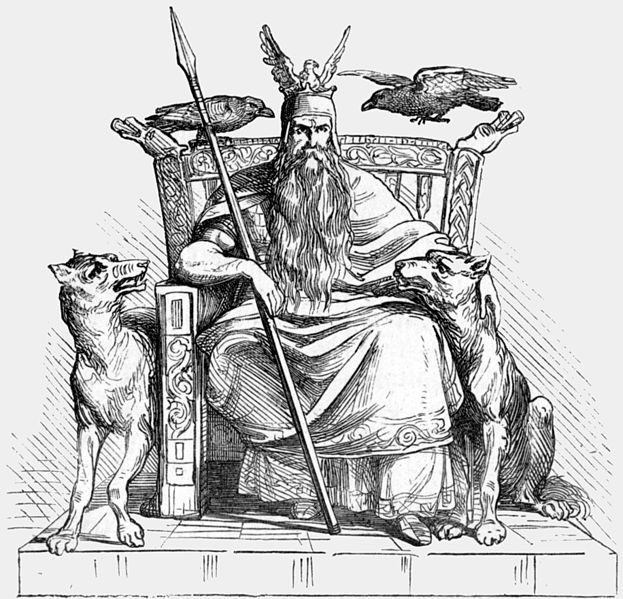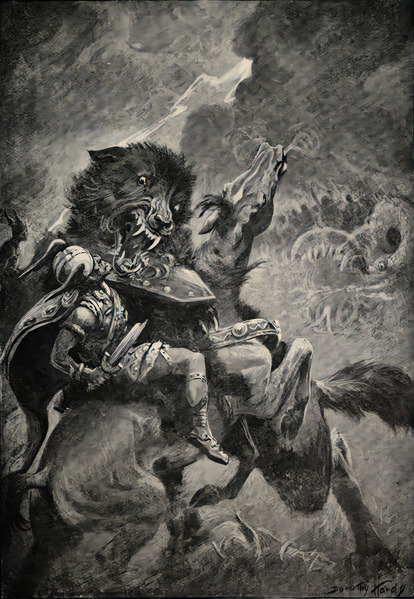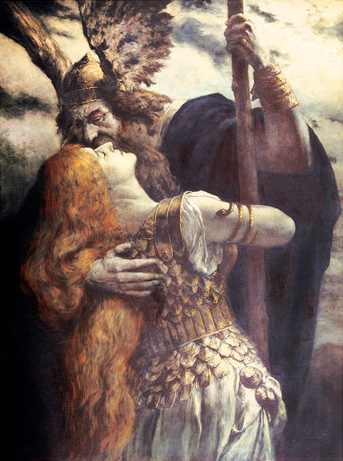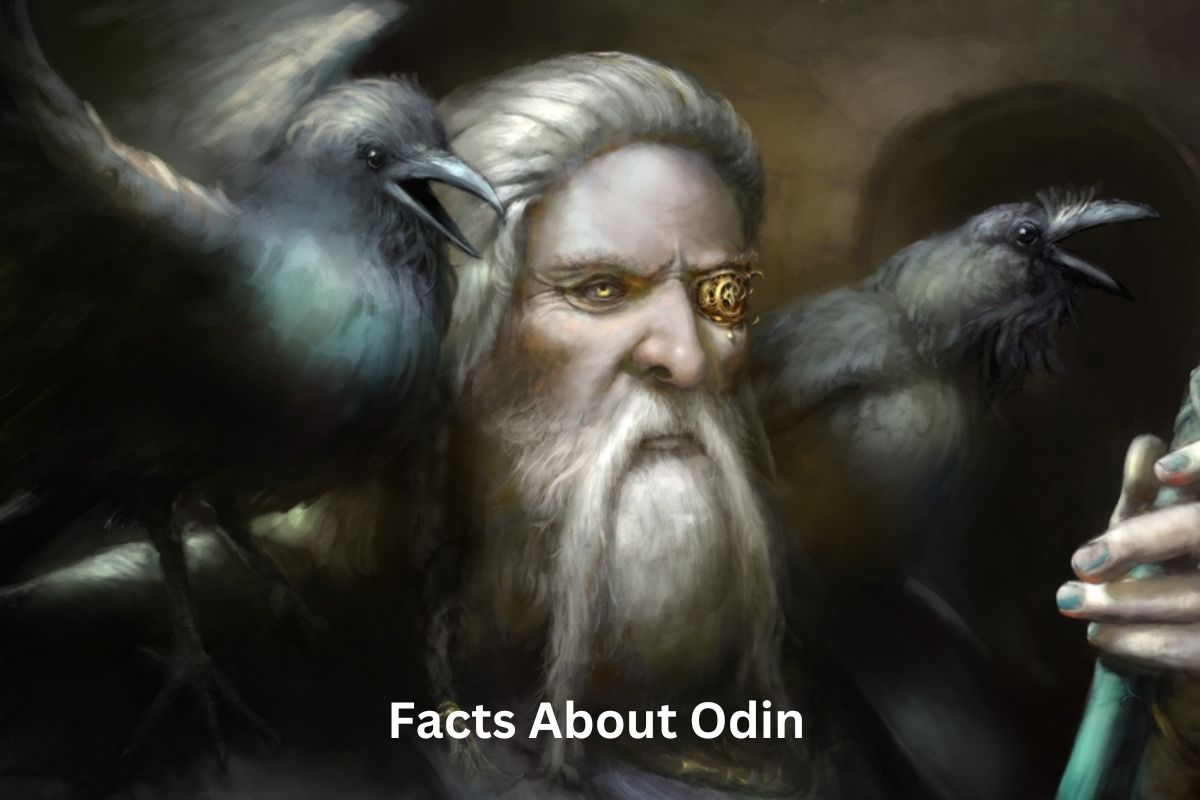Odin, often referred to as the Allfather, is a central figure in Norse mythology and the chief of the Aesir gods. He is a complex deity associated with wisdom, war, poetry, and death.
Odin is known for his insatiable thirst for knowledge, symbolized by his two ravens, Huginn and Muninn, who gather information from the world.
He is depicted with one eye, having sacrificed the other at the Well of Wisdom to gain greater insight. Odin also owns the legendary eight-legged horse, Sleipnir, and wields the powerful spear, Gungnir.
As the ruler of Valhalla, he selects brave warriors to prepare for the final battle, Ragnarök. Odin’s character embodies both the intellectual pursuit of wisdom and the martial aspects of a warrior god, making him a central and captivating figure in Norse mythology.
Odin Facts
1. Odin is also known as Woden, Wotan, and the Allfather
Odin, known as Óðinn in Old Norse, is one of the principal deities in Norse mythology. He goes by various names and titles in different cultures and contexts.
Also Read: Facts About Freyja the Norse Goddess
“Woden” and “Wotan” are Old English and Old High German variations of his name, respectively.
“Allfather” is a title frequently ascribed to Odin. It reflects his role as the chief god and father figure of the Aesir gods in Norse mythology. This title emphasizes his position as the progenitor and leader of the divine pantheon.

2. Odin is the god of wisdom, war, poetry, and death
Odin is a multifaceted deity with domains that encompass both wisdom and war. This duality is a central aspect of his character.
As the god of wisdom, Odin is associated with intellectual pursuits, knowledge-seeking, and poetry. He is credited with discovering the runic alphabet and is known for his insatiable thirst for wisdom and knowledge.
Also Read: Loki Facts
In his role as the god of war, Odin is the patron of warriors and battle. He inspires courage and valor in warriors, and his presence on the battlefield is believed to bring victory to his chosen champions. He also presides over the selection of warriors to join him in Valhalla, the warrior’s paradise.
3. He has two ravens named Huginn and Muninn
Odin is typically depicted with two ravens, Huginn and Muninn, perched on his shoulders or flying around him.
Huginn and Muninn represent thought and memory, respectively. They serve as Odin’s messengers and scouts, traveling throughout the Nine Worlds to gather information and bring it back to him.
The presence of these ravens underscores Odin’s relentless pursuit of knowledge and his desire to stay informed about events in the mortal and divine realms. They are symbols of his wisdom and his role as a shrewd and strategic deity.
4. Odin owns an eight-legged horse named Sleipnir
Odin is the owner of Sleipnir, an extraordinary eight-legged horse, which is one of the most iconic creatures in Norse mythology.
Sleipnir’s origin story is quite unique. It was born as the result of a peculiar union between Loki, the trickster god, and a giantess named Svadilfari.
Loki had transformed into a mare to distract a powerful stallion belonging to a giant who was constructing the walls of Asgard. This unusual union resulted in the birth of Sleipnir.
Sleipnir is known for its incredible speed and ability to traverse great distances effortlessly. Odin often rides Sleipnir on his journeys through the Nine Worlds, making it a symbol of Odin’s connection to different realms and his role as a traveler between them.

5. He sacrificed an eye for knowledge
Odin’s quest for wisdom and knowledge is exemplified by the story of his self-sacrifice at Mímir’s well, which is often referred to as the “Well of Wisdom.”
According to the myth, Odin hung himself from the world tree, Yggdrasil, for nine days and nights. He did this as a sacrifice to gain knowledge and insight into the mysteries of the cosmos.
During this time, he deprived himself of sustenance and stabbed himself with his own spear. As a result of this ordeal, he gained profound knowledge and wisdom, which he shared with the world. Odin’s willingness to undergo such a sacrifice demonstrates his dedication to acquiring knowledge at any cost.
6. Odin rules the warrior afterlife realm of Valhalla
Odin is the ruler of Valhalla, a majestic hall located in Asgard, the realm of the gods. Valhalla is where brave warriors who died in combat are taken after their deaths.
These warriors, known as the Einherjar, are chosen by Odin to dwell in Valhalla. They spend their afterlife training for the final battle, Ragnarök, under Odin’s guidance.
Odin’s role as the ruler of Valhalla emphasizes his connection to warfare and his role as a god who selects and honors those who die valiantly in battle. It also underscores his preparation for the impending cataclysmic events of Ragnarök, in which he will play a central role.
7. He wields a powerful spear called Gungnir
Gungnir is the name of Odin’s powerful and legendary spear in Norse mythology.
It is considered one of the most formidable weapons in the Norse pantheon. Gungnir is said to be perfectly balanced and constructed, ensuring that it never misses its target.
Odin’s possession of Gungnir underscores his martial prowess and leadership on the battlefield. It’s a symbol of his authority and strength as a god of war.

8. Odin is depicted as an older man with one eye
Odin’s distinctive appearance is often depicted with one eye, as mentioned earlier he is said to have sacrificed his eye at Mímir’s well in exchange for wisdom and insight.
This missing eye is a symbol of Odin’s commitment to gaining knowledge, even if it comes at a great personal cost. It also serves as a reminder of his wisdom and the sacrifices he is willing to make for the betterment of the cosmos.
Odin’s one-eyed visage makes him easily recognizable in Norse art and mythology.
9. He discovered the runic alphabet
Odin is credited with discovering the runes, an ancient system of writing and divination in Norse culture.
According to myth, Odin hung himself on Yggdrasil, the world tree, for nine days and nights as a sacrifice to learn the secrets of the runes. This knowledge of the runes allowed him to tap into the magical and mystical aspects of the cosmos.
Runes were not only used for communication but also for casting spells, making charms, and foretelling the future. Odin’s connection to the runes demonstrates his mastery over both the mundane and the mystical aspects of existence.
10. Odin plays a key role in the Norse apocalypse, Ragnarök
In Norse mythology, Ragnarök is the apocalyptic event that signifies the end of the world. Odin plays a pivotal role in these cataclysmic events.
He leads the Aesir gods into battle against a host of chaotic forces, including the monstrous wolf Fenrir and the Midgard Serpent, Jörmungandr. This epic final battle is destined to bring about the destruction and rebirth of the world.
Odin’s willingness to confront the forces of chaos and his role as a central figure in Ragnarök illustrate his bravery and his sense of duty as the chief of the gods.
